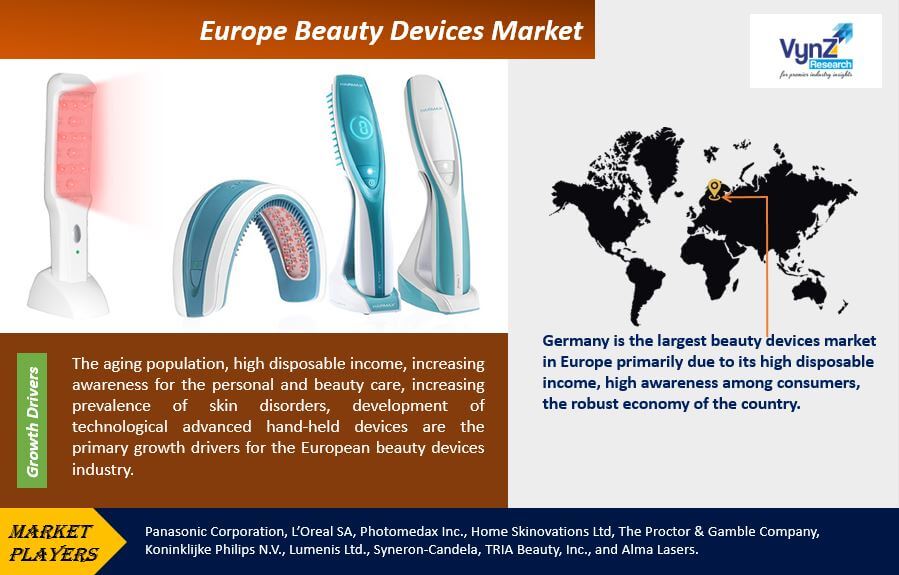Industry Overview
The European Beauty Devices Market is expected to grow at a CAGR of 17.6% during the forecast period with its market size predicted to reach USD 25.7 billion by 2030. The European beauty devices market is primarily driven by factors such as aging population, high prevalence of skin disorders, and high awareness in the region for beauty and personal care. Also, the adoption of premium devices and high disposable income in the region also support the growth of the market. hair removal devices, acne devices, cleansing devices, light/led therapy and photo rejuvenation devices, cellulite reduction devices are the major contributor to the beauty devices industry in the region.

Market Segmentation
Insight by Type
On the basis type of devices, the market is categorized into cellulite reduction devices, hair removal devices, acne devices, cleansing devices, light/led therapy and photo rejuvenation devices, hair growth devices, oxygen and steamer devices, skin dermal rollers and others. Among the various type of beauty devices, hair removal devices hold the largest share in the market due to the increasing awareness regarding hair fall and the availability of a wide range of hair removal devices, such as trimmers, clippers, epilators, and shavers.
Insight by End User
The primary end users of beauty devices in Europe are beauty clinics, spas and salons, and at home users. Among all end users, the spas and salons are estimated to account for the largest share of the European beauty devices market size in 2018 and the demand for beauty devices is anticipated to remain the largest in the spas and salons. Also, with the technological advancements and development of premium hand-held devices, the demand for at-home beauty devices is expected to increase significantly during the forecast period.
Europe Beauty Devices Market Report Coverage
|
Report Metric
|
Details
|
|
Historical Period
|
2018 - 2023
|
|
Base Year Considered
|
2024
|
|
Forecast Period
|
2025 - 2030
|
|
Market Size in 2024
|
U.S.D. xx.x Billion
|
|
Revenue Forecast in 2030
|
U.S.D. 25.7 Billion
|
|
Growth Rate
|
17.6%
|
|
Segments Covered in the Report
|
By Type and By End-User
|
|
Report Scope
|
Market Trends, Drivers, and Restraints; Revenue Estimation and Forecast; Segmentation Analysis; Impact of COVID-19; Companies’ Strategic Developments; Market Share Analysis of Key Players; Company Profiling
|
|
Regions Covered in the Report
|
Germany, France, U.K., Italy, Spain, Russia, Poland, Netherlands
|
Industry Dynamics
Growth Drivers
The aging population, high disposable income, increasing awareness for personal and beauty care, increasing prevalence of skin disorders, and development of technologically advanced hand-held devices are the primary growth drivers for the European beauty devices industry. European countries are among the leading countries in terms of per capita income. This illustrates the high affordability of beauty devices by consumers in the region. For instance, as per the World Bank data, the GDP per capita of Germany, France, U.K., Italy, and Spain, was USD 23,687.32, USD 22,433.56, USD 27,427.59, USD 20,400.81, and USD 15,323.61 respectively in 2001, which increased to USD 44,469.91, USD 38,476.66, USD 39,720.44, USD 31,952.98, 28,156.82 in 2017.
The European population is aging at a rapid pace, which creates a huge demand for beauty devices in the region. As per the World Bank, 16.47% population of Germany and 16.01% population of France was aged 65 or above in 2000, and the percentage increased to 21.45% and 19.72% respectively by 2017.
Challenges
The key challenges faced by the industry players in Europe are stringent government regulations which delays product launches, product recalls, and sluggish economic growth.
Geographic Overview
Geographically, Germany is the largest beauty devices market in Europe primarily due to its high disposable income, high awareness among consumers, the robust economy of the country. Germany is one of the largest consumers of premium beauty devices, with its population willing to pay for quality products. France is predicted to observe the highest growth in the market among different countries in the region. The presence of a large number of industry players, investment in research and development for better treatment options and consumer willingness to pay leads to the highest growth in the French beauty devices industry.
Competitive Insight
Lumenis Be Ltd is an energy-based medical device company for aesthetic and ophthalmic applications in the field of minimally invasive clinical solutions. It manufactures and distrdibutes medical and aesthetic lasers and light-based systems.
Tria Beauty transform a professional hair removal laser into a hand-held, easy-to-use device that delivered permanent results.
Some of the players operating in the European beauty devices industry are Panasonic Corporation, L’Oreal SA, Photomedax Inc., Home Skinovations Ltd, The Proctor & Gamble Company, Koninklijke Philips N.V., Lumenis Ltd., Syneron-Candela, TRIA Beauty, Inc., and Alma Lasers.
Recent Developments by Key Players
Candela launched the all-new Profound Matrix system. This multi-application system features the Sublime, Sublative RF and all-new Matrix Pro applicators which is designed to correct, maintain, and restore skin at various stages of the aging journey.
Henkel AG & Co. KGaA acquired Arsenal Capital Partners, a private equity firm specializing in investments in industrial and healthcare companies.
Industry Segmentation
The Europe Beauty Devices Market report offers a comprehensive market segmentation analysis along with an estimation for the forecast period 2025–2030.
Segments Covered in the Report
- By Type
- Cleansing Devices
- Hair Removal Devices
- Skin Dermal Rollers
- Acne Devices
- Light/LED Therapy and Photo Rejuvenation Devices
- Oxygen and Steamer Devices
- Hair Growth Devices
- Cellulite Reduction Devices
- Others
- By End-User
- Beauty Clinics
- Spas and Salons
- at Home
- Others
Region Covered in the Report
- Europe
- Germany
- U.K.
- France
- Italy
- Spain
- Russia
- Rest of Europe
Primary Research Interviews - Breakdown
%20System%20Market.png)




%20System%20Market.png)